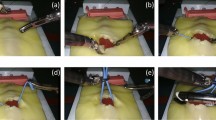Abstract
A number of remote robotic catheter systems have been developed to protect physicians from X-ray exposure in endovascular surgery. However, the teleoperation prevents the physicians sensing the force directly which may easily result in healthy vessels injured. To realize the safe operation, a tissue protection-based VR training system has been developed in this paper to prevent collateral damage by collision. The integrated VR simulator cannot only remind the novice possible collisions by visual signs, but also cooperate with the newly designed tissue protection mechanism to remit collision trauma beforehand. Such mechanism exploits the diameter variable pulley in order to implement the safe interaction between catheter and vasculature. To testify the effectiveness of the tissue protection in training system, we invited four non-medical students to participate the successive 5 days training session. The evaluation results show that the average impingement distance (representing tissue damage) to vascular wall has been reduced to 0.6 mm, and the collision frequency is greatly decreased which implies the realization of relative safe catheterization.













Similar content being viewed by others
References
Fu Q, Guo S, Yamauchi Y et al (2015) A novel hybrid microrobot using rotational magnetic field for medical applications. Biomed Microdevices 17(2):1–12
Vania T, De Lin M, Desgranges P, Deux J-F et al (2013) Image guidance for endovascular repair of complex aortic aneurysms: comparison of two-dimensional and three-dimensional angiography and image fusion. J Vasc Interv Radiol 24(11):1698–1706
Khan EM, Frumkin W, Andre Ng G, Neelagaru S et al (2013) First experience with a novel robotic remote catheter system: Amigo™ mapping trial. J Interv Card Electrophysiol 37(2):121–129
Salimi A, Ramezanifar A, Mohammadpour J, and Grogoriadis KM 2013. Development of a master-slave robotic system for MRI-guided intracardiac interventions. Proceedings of the ASME 2013 Dynamic Systems and Control Conference, pp.V001T08A005-V001T08A005
Mitsuishi M, Morita A, Sugita N, Sora S et al (2013) Master–slave robotic platform and its feasibility study for micro-neurosurgery. Int J Med Rob Comput Assisted Surg Vol.9, no.2:180–189
Xiao N, Shi L, Gao B, Guo S et al (2013) Clamping force evaluation for a robotic catheter navigation system. Neurosci Biomed Eng 1(2):141–145
Guo J, Guo S, Yu Y 2016 Design and characteristics evaluation of a novel teleoperated robotic catheterization system with force feedback for vascular interventional surgery. Biomedical microdevices. In press
Yin X, Guo S, Xiao N et al (2016) Safety operation consciousness realization of MR fluids-based novel haptic interface for teleoperated catheter minimally invasive surgery. IEEE/ASME Transactions on Mechatronics 21(2):1043–1054
Zhou C, Xie L, Shen X, Luo M et al (2015) Cardiovascular interventional surgery virtual training platform and its preliminary evaluation. Int J Med Rob Comput Assisted Surg 11(3):375–387
Alaraj A, Lemole MG, Finkle JH , Yudkowsky R et al 2011 Virtual reality training in neurosurgery: review of current status and future applications
Erick J, Zhang Y, Shimada K (2011) Estimating an equivalent wall-thickness of a cerebral aneurysm through surface parameterization and a non-linear spring system. Int J Numer Methods Biomed Eng 27(7):1054–1072
Zhang D, Wang T, Liu D, Lin G (2010) Vascular deformation for vascular interventional surgery simulation. Int J Med Rob Comput Assisted Surg 6(2):171–177
Wen T, Wan TR, Gould GA et al (2012) A stable and real-time nonlinear elastic approach to simulating guidewire and catheter insertions based on cosserat rod. IEEE Trans Biomed Eng 59(8):2211–2218
Wang Y, Guo S, Tamiya T, Hirata H, Ishihara H (2015) A blood vessel deformation model based virtual-reality simulator for the robotic catheter operating system. Neurosci Biomed Eng 2(3):126–131
Morris Dan, Hong Tan, Federico Barbagli, Timothy Chang, et al. Haptic feedback enhances force skill learning. Proceedings of the symposium on haptic interfaces for virtual environment and teleoperator systems, pp. 21–26 2007.
Wang Y, Guo S, Tamiya T, Hirata H, Ishihara H A virtual-reality simulator and force sensation combined catheter operation training system and its preliminary evaluation. Int J Med Rob Comput Assisted Surg. doi:10.1002/rcs.1769, 2016
Reddy Vivek Y, Shah D, Kautzner J, Schmidt B et al (2012) The relationship between contact force and clinical outcome during radiofrequency catheter ablation of atrial fibrillation in the TOCCATA study. Heart Rhythm 9(11):1789–1795
Okumura Y, Johnson SB, Bunch TJ, Henz BD et al (2008) A systematical analysis of in vivo contact forces on virtual catheter tip/tissue surface contact during cardiac mapping and intervention. J Cardiovasc Electrophysiol 19(6):632–640
Francesco P, Kevin Heist E, Danik SB, Barrett CD et al (2011) Assessment of catheter tip contact force resulting in cardiac perforation in swine atria using force sensing technology. Circ Arrhythm Electrophysiol 4(2):218–224
Di Biase L, Natale A, Barrett C, Tan C et al (2009) Relationship between catheter forces, lesion characteristics,“popping,” and char formation: experience with robotic navigation system. J Cardiovasc Electrophysiol 20(4):436–440
Khoshnam M, Yurkewich A, and Patel RV 2013 Model-based force control of a steerable ablation catheter with a custom-designed strain sensor. Proceedings of the IEEE International Conference on Robotics and Automation, pp.4479–4484
Gelman D, Skanes A, Tavallaei MA, Drangova M (2016) Design and evaluation of a catheter contact-force controller for cardiac ablation therapy. IEEE Trans Biomed Eng. doi:10.1109/TBME.2016.2525929
Ong CJ, Gilbert EG (1997) The Gilbert-Johnson-Keerthi distance algorithm: A fast version for incremental motions. Proceedings of 1997 I.E. International Conference on Robotics and Automation 2:1183–1189
Author information
Authors and Affiliations
Corresponding author
Rights and permissions
About this article
Cite this article
Wang, Y., Guo, S., Li, Y. et al. Design and evaluation of safety operation VR training system for robotic catheter surgery. Med Biol Eng Comput 56, 25–35 (2018). https://doi.org/10.1007/s11517-017-1666-2
Received:
Accepted:
Published:
Issue Date:
DOI: https://doi.org/10.1007/s11517-017-1666-2




